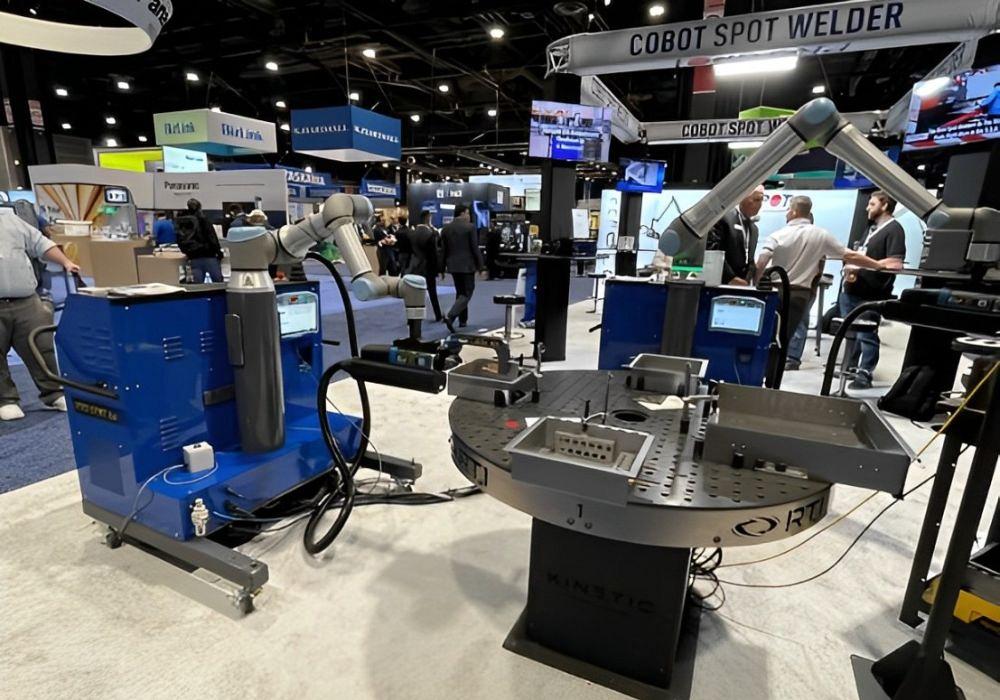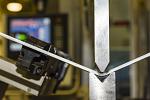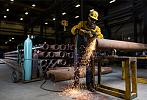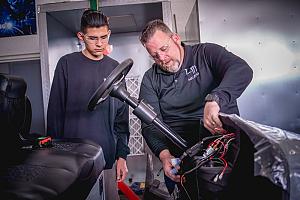Editor-in-Chief
- FMA
- The Fabricator
- FABTECH
- Canadian Metalworking
Categories
- Additive Manufacturing
- Aluminum Welding
- Arc Welding
- Assembly and Joining
- Automation and Robotics
- Bending and Forming
- Consumables
- Cutting and Weld Prep
- Electric Vehicles
- En Español
- Finishing
- Hydroforming
- Laser Cutting
- Laser Welding
- Machining
- Manufacturing Software
- Materials Handling
- Metals/Materials
- Oxyfuel Cutting
- Plasma Cutting
- Power Tools
- Punching and Other Holemaking
- Roll Forming
- Safety
- Sawing
- Shearing
- Shop Management
- Testing and Measuring
- Tube and Pipe Fabrication
- Tube and Pipe Production
- Waterjet Cutting
Industry Directory
Webcasts
Podcasts
FAB 40
Advertise
Subscribe
Account Login
Search
A visit to Automate 2024 reveals the future might be now
Fabricators won’t have to wait long before they see these innovations on their own shop floors
- By Dan Davis
- May 9, 2024
- Article
- Automation and Robotics

Pro Spot Automation’s Cobot Automated Welding Workcell made its debut at Automate in 2023. At this year's show, it was paired with a rotary table to get more production out of the automated spot welding equipment.
Those that think the future of automation will come in the shape of a humanoid robot might want to think again. For the foreseeable future, at least in the manufacturing space, automation is likely to look a lot like it does now.
While many have in mind a future where robots look sort of like the humans that built them—a head on a torso with two arms and two legs—in the manufacturing world, robots are likely to have an arm and be based on a cart. It’s not the stuff of a sci-fi movie, but it’s definitely more realistic, which should appeal to manufacturing companies of all sizes.
At Automate 2024 in Chicago May 6-9, that pragmatic approach to automation was very much evident. For all the talk of artificial intelligence in the manufacturing world, exhibitors showcased automation and robotic offerings that are still designed to solve basic manufacturing problems—not necessarily anything that generates thousands of internet clicks, but something that manufacturers are sure to value.
“Between UR robots, MiR AMRs [autonomous mobile robots], and mobile cobots, we can take on almost any application on the shop floor,” said Ujjwal Kumar, group president of Teradyne Robotics, which includes Universal Robots (UR) and Mobile Industrial Robots (MiR).
The mobile cobot is the next generation of cobots on the shop floor, Kumar said. With this automation arrangement, a manufacturer gets the flexibility, reach, and dexterity of a cobot arm that tends to a machining center or works a press brake and then moves, perhaps with parts, to another station. At that point, the cobot can work its way back to the starting point to repeat the process or even head off for another task. The ability to do multiple jobs is just what manufacturers need, considering the challenge they experience looking for workers, Kumar added.
In its Automate booth, UR demonstrated a mobile cobot from Enabled Robotics, comprising the MiR250 AMR and a 20-kg UR cobot, picking up and returning baskets to nearby shelves. With the incorporation of artificial intelligence and the AMR’s analytic software, these mobile cobots can deal with unstructured environments, minimizing programming requirements for manufacturers.
Having the cobot accomplish a task while the AMR is moving is the real goal, Kumar said. It maximizes automation’s potential in manufacturing applications—and is difficult for humans to duplicate.
“We know a robot can do what a human can do. You don’t want that,” he said. “You want robots to do the superhuman tasks.”
Cobots Getting Smarter
Neura Robotics made its North American debut at Automate 2024 with its line of what it calls cognitive robots. David Reger, founder and CEO, said that by incorporating audio sensors, force sensors, and cameras into the cobot; incorporating artificial intelligence into the control software; and allowing for speech-based commands, the final limitations to useability and scalability challenges are removed.
Reger said that Neura’s multisensing cobot MAiRA can learn tasks in parallel, not relying on just one person or one sensory input but instead using its other sensory inputs and initial programming to accomplish a given job.

The Automate tradeshow, sponsored by the Association for Advancing Automation, welcomed attendees May 6-9 at McCormick Place in Chicago. While the event covered many industry sectors, the manufacturing industry was a major focus.
In Neura’s booth, multiple cobots participated in a picking exercise in which colored light projections filled a tabletop and each cobot had to reach for the one it was programmed to pick up. Relying on their vision systems, the arms avoided collisions even as the projections moved to different locations on the tabletop.
“Only 1% of the world can program robots,” Reger said. “We want to make that possible for the other 99%.”
Kawasaki Robotics is partnering with Neura in launching its CL series of cobots, its first foray into the space. The formal debut of the cobots occurred at Automatica in Munich in June 2023. The two companies shared a champagne toast on the first day of Automate to mark the North American announcement of the partnership.
Micropsi Industries, meanwhile, is making cobot and robot programming much easier with its MIRAI software, which uses visual information collected by off-the-shelf camera components to teach the automated arms to accomplish tasks without the use of CAD files and teaching pendants. The software allows the robot to handle all sorts of variabilities in a job in real time.
At its Automate booth, Micropsi demonstrated how a cobot could pick up a flat metal part repeatedly, even as the part tilted in various ways as it sat on top of crumpled paper. With the ability to see the placement of the part, the MIRAI software had the cobot adjust its pick-up angle.
“We’re automating things that people thought couldn’t be automated,” said Matt Jones, vice president, sales and operations, Micropsi.
Gary Jackson, Micropsi’s CEO, described one potential application at an appliance manufacturing facility that had a success rate of just over 80% on leak testing of copper tubing. The weld joints in the copper tubing were never in the same place from one appliance to the next, making automation a challenge. Jackson suggested that the Micropsi software on a robotic arm could allow for the arm to find each joint, where potential leaks would occur, and conduct a leak test without fear of missing something.
“The industry has a gap. The manufacturing space has been trying to solve problems with technologies that are 10, 15, or 20 years old, and they have given up. In the places where we have found success, it’s because we were innovative and creative in finding solutions to real, immediate problems,” Jackson said.
Cobots Getting Bigger
Another major trend in the automation space is that cobots are getting bigger. That’s good news for manufacturers looking for cobots to handle larger parts and to reach further, but it also comes with some concerns. Even though cobots are designed to work in the presence of humans, the larger sizes raise the stakes a bit.
Mike DeGrace, UR’s ecosystem manager, made that point as he talked about emerging trends in collaborative automation during an early morning presentation on Monday, May 6. Larger cobots, such as the UR 20-kg model, which has a 2-m reach, are much more challenging to program. A cobot capable of picking up heavy parts also can move those parts—and possibly could hit someone not paying attention to their surroundings. Given that these larger cobots are now about the same height as a typical human worker, these automated arms are working at head level, presenting extra concern.

Collaborative robots and autonomous mobile robots, such as this UR cobot and MiR unit, have been two important automation trends in recent years. The next evolution of these devices has them working together to introduce even more shop floor efficiencies.
All of this means that manufacturers have to be more aware of the new safety factors that come with larger cobots. Power- and force-limiting designs ensure that cobots will stop immediately when any unexpected or abnormal impact occurs; this applies to the larger models as well. To prevent these collisions from occurring, speed and separation monitoring helps to adjust cobot performance, and even stop it, if necessary, when people are present.
Hirebotics COO Matthew Bush said that he’s seeing customers use cobots in even more heavy-duty fabricating scenarios. He described one application in which two 20-kg cobots on two 10-ft. tables were placed on either side of an 8- by 8-ft. workpiece for welding. The reach of these larger cobots allowed the manufacturer to ditch a fixed automation system and set up a welding cell with easier-to-program cobots.
“It’s really about easy of use,” Bush said. “Finding a robot programmer is about as hard as finding a welder."
Metal fabricators interested in checking out some of the latest in automation advancements tailored to manufacturing should consider attending FABTECH 2024 in Orlando, Fla., Oct. 15-17. Meanwhile, Automate returns to Detroit next year, May 12-15.
About the Author

Dan Davis
2135 Point Blvd.
Elgin, IL 60123
815-227-8281
Dan Davis is editor-in-chief of The Fabricator, the industry's most widely circulated metal fabricating magazine, and its sister publications, The Tube & Pipe Journal and The Welder. He has been with the publications since April 2002.
subscribe now

The Fabricator is North America's leading magazine for the metal forming and fabricating industry. The magazine delivers the news, technical articles, and case histories that enable fabricators to do their jobs more efficiently. The Fabricator has served the industry since 1970.
start your free subscription- Stay connected from anywhere

Easily access valuable industry resources now with full access to the digital edition of The Fabricator.

Easily access valuable industry resources now with full access to the digital edition of The Welder.

Easily access valuable industry resources now with full access to the digital edition of The Tube and Pipe Journal.
- Podcasting
- Podcast:
- The Fabricator Podcast
- Published:
- 05/14/2024
- Running Time:
- 62:12
Cameron Adams of Laser Precision, a contract metal fabricator in the Chicago area, joins the podcast to talk...
- Trending Articles
What software automation means for custom fabrication

Why employee-owned companies make sense in manufacturing

Press brakes, panel benders, and flat blank calculations

Nucor’s weekly steel price announcement continues to rattle markets

Educating, rather than just training, tomorrow's workforce

- Industry Events
Laser Welding Certificate Course
- May 7 - August 6, 2024
- Farmington Hills, IL
World-Class Roll Forming Workshop
- June 5 - 6, 2024
- Louisville, KY
Advanced Laser Application Workshop
- June 25 - 27, 2024
- Novi, MI
Precision Press Brake Certificate Course
- July 31 - August 1, 2024
- Elgin,



























